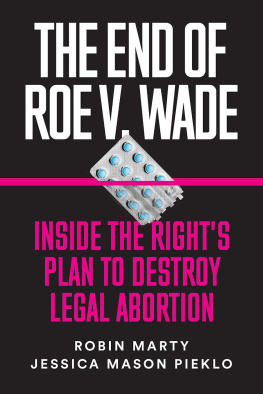
In my writing, I try desperately to avoid clichs. However, I am forced to begin this chapter with one of the most common ones in the English language: This was a team effort. While everyone on staff at Life Dynamics played a role, it was primarily Christina Dunigan, Mona Passignano, Dzintra Brugman Tuttle, and Lisa Dodson who helped me turn the mountain of data we accumulated into LIME 5. Because of their commitment, and the efforts of my wife, Tulane, the American people now have an opportunity to know whats really going on inside the abortion industry. Other staff members who worked on this project were: Tom Cyr, Marco Medina, Rita Lanning, Christine Cartin, Debbie Black, Natasha Sanford, Scott Stirling, Louann Lawson, and Robert Webb. Among non-staff people who made a significant contribution to the project were Lisa Beaulieu, Rachel MacNair, Denise Makura-Tromski, and Scott Somerville.
Whatever else these people do in their lives, they can always say with pride that they were indispensable members of a team that had the courage to tell the world a story no one else would. I am extremely proud of, and grateful to, each one of them. And though shes only five years old and too young to realize the role she played, I want to also thank my precious daughter, Sheila. Whenever things were not going well and the stress was becoming unbearable, hearing her running down the hallway toward my office was exactly what I needed to keep going.
During the research for this book, my office received information from more than 200 sources, and when the process was complete, our file of usable documents had grown from just over 2,000 to almost 6,000. If you are one of the many unselfish people who helped, I want you to realize that whether you sent a little or a lot, this book would have never happened without you. I want to also thank those people who work undercover for us in the abortion industry. For reasons you understand better than anyone, I am not able to publicly thank you by name, but I hope you know how appreciated you are.
If you provided information for this project but were left off the following list, please accept my apology and my appreciation.
Advocates for Life Ministries
American Life League
American Rights Coalition
Americans United for Life
Ted Amshoff
Patricia Balaguer
Heather Brown
Nick Cicali
Cincinnati Right to Life
Brian Clowes
Mike and Vickie Conroy
Lynn Copeland
Mary Kay Culp
Mike Dare
The Denton, Texas, Public Library
Paul dePairre
Larry Donlan
Betty Essex
Kathleen Essex
Carol Everett
Feminists for Life of America
Mark Gabriel
Ted Gerk
Bill Graham
Jean Gunter
Josephine Guy
Jeannie Hill
Jim Holman
Human Life International
Human Life of Washington
Jack Humphries
Robin Jones
Mary Josius
Susan Jurecka
KS Research
Bill Lasley
Ann Leach
Legal Action for Women
Life Advocates/Houston
Life Issues Institute
Richard and Pam Mahoney
Ernest and Kathy McConnell
Vivian McNeme
Jim Miller
Elaine Morley
Lynn Murphy
Tim Murphy
Michael Noonan
Jerry Orris
Craig Parker
Michael Passignano
Fr. Frank Pavone
Priests for Life
Pro-Life Action League
Pro-Life Action Ministries
Meredith Raney
David Reardon
Right to Life of Rhode Island
Joe Scheidler
Tom Smith
Anna Sullivan
Neil Sullivan
Matt Trewella
John Walker
Ron and Mary Weaver
Lynn and Eddie Webb
Dr. Jack and Barbara Willke
Fr. Paul Witt
Charlie Wysong
Brian Young
The primary argument of abortion proponents has always been that abortion must be legal so it will be safe. It is an argument that clearly strikes a chord with some of the American people. Although most of them admit to being profoundly uncomfortable with the idea of abortion, many reluctantly support its legality solely on the basis of maternal safety.
But as the evidence in this chapter will show, in the real world the abortion industrys safety argument is a complete fraud. After more than twenty years of legalization, they have yet to even approach minimal safety standards, and American women are being butchered because of it.
Of course, proponents of legalized abortion will contend that the abuses detailed in this chapter are relatively few compared to the number of abortions performed. They will rightly point out that all surgery has some degree of risk and a few thousand failures out of more than thirty million procedures is not an unacceptable safety record.
This viewpoint erroneously assumes that the examples cited here represent all or at least most of the instances of malpractice, injury, and death. In reality, limited by our inexperience at medical research and a relatively tiny budget, our findings no more than scratched the surface.
To begin with, gaining full access to accurate data would require the cooperation of the abortion industry as well as the state and local government agencies responsible for compiling such data. Unfortunately, due to their political agendas (see Chapter 3), they have little interest in reporting abortion industry disasters, and lots of interest in covering them up. Since the mainline media, as well as some elements within the medical establishment, are participants in the cover-up, all research in this field becomes totally dependent on whether abortion-injured women seek redress in the legal system. When they dont, which is usually the case (see Chapter 4), they become invisible to researchers and eliminate the only reliable source of data about abortion injuries. During the research for this book, we stumbled across hundreds of horror stories about things that happened to women at abortion clinics, and in virtually every case we had no reason to believe that they were not true. But if the woman involved didnt file a suit, report it to the medical licensing board, or call the police, we didnt even keep a record of it much less consider it for the book.
We were also hampered because attorneys are understandably reluctant to talk about ongoing cases or cases that have not yet been filed. That is the main reason there are a disproportionate number of cases from the 1970s or 1980s compared to the 1990s. Malpractice cases take an average of two to five years to get to trial, and during that time it is extremely difficult, if not impossible, to get details about them. Therefore, there are fewer cases discussed here from the late 1980s to the present than from the preceding years. However, dont let that mislead you to believe that fewer injuries and deaths are occurring or that the abortion industry cleaned up its act. At Life Dynamics, we are currently providing litigation support in 84 abortion-malpractice cases, 11 of which involve the death of the woman having the abortion, and only one of those cases is included in this chapter. Because it often takes years for information about abortion-malpractice cases to be discoverable by independent researchers, no book written on this subject is ever going to have a high number of recent casesregardless of how many there actually are.
Another factor limiting research into this field is that the majority of these cases are settled before trial. Thats a problem for two reasons. First, most abortionists demand a confidentiality agreement as part of their willingness to settle a case. Second, legal research services track only cases that actually go to trial. So, except in those rare instances in which a settled case is sensational enough to be covered by the media, there is little chance that we could even find out it exists.
Next page












